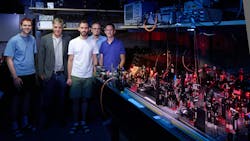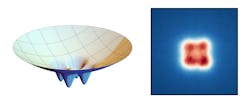Researchers in Germany are making their mark on light particles, quite literally, in work that could someday make communication between multiple participants tap-proof.
The team, from the Institute of Applied Physics (IAP) at the University of Bonn, designed an approach in which a simple lattice structure can be imprinted onto a Bose-Einstein condensate “super photon”—a unique state of matter in which many particles behave as one, moving together in the same direction at the same speed. When cooled to a very low temperature these particles behave like a single photon (see video).
How does it work?
In a series of experiments, the IAP team assembled an optical microcavity made of one plane mirror and one with a microstructured surface comprised of four small sites arranged in a square and surrounded by a quadratic elevation of the surface.
“This structure is prepared before doing the actual experiment, using the principle of thin-film delamination,” says Andreas Redmann, a Ph.D. student and researcher who co-led this work. When assembled in a cavity, he explains, the resonator modes are shaped according to the surface structure on the mirrors.
“In our case, we are working with a lowest-energy mode in the resonator,” Redmann says. “This is formed as the result of hybridizing the bare states of the four separate sites, with photons coherently tunneling between the sites.”
This coherently split ground state, which has no phase winding—defined as the arrangement of coils within a generator that creates a rotating magnetic field—is populated by cooling the photons to room temperature. It’s ultimately achieved by radiatively coupling the light to a bath of dye molecules, also at room temperature. Essentially, the photons can then coherently tunnel between the four sites.
The state preparation functions via thermodynamic methods, such as cooling, and is “intrinsically very stable,” Redmann says, adding that this work shows the team’s approach can, in fact, generate complex states of light.
Findings
In their study, the team says that the photon Bose-Einstein condensate being formed in a state that is coherently split over all four sites and has no phase winding along the formed ring is a significant finding.
“This implies an efficient new way of preparing photon states with a well-controllable structure in the spatial emission pattern from the resonator,” Redmann says.
Generating optical quantum states by exploiting thermodynamics could efficiently generate highly entangled optical quantum states at high production rates. Aided by optical nonlinearity (in which the response of a material to light is not directly proportional to the light's intensity), the material's optical properties change in a nonlinear way with increasing light intensity.
This all makes the approach well suited for applications including quantum cryptography among more than just two sites, Redmann says.
What’s next?
The team is now working toward more precise control.
“We want to improve the precise control over the tunneling amplitudes for photons between sites,” Redmann says. The team also plans to supplement their experiments with internal optical nonlinearity, which could allow them to scale to larger system sizes and enable use for quantum key distribution. Certain emission patterns could also potentially be created for use in applications such as securing communications.
“For the future,” Redmann says, “when a complex quantum state of the light field constitutes the ground state in the cavity array of multiple sites, our method gives a way to populate such states by mere cooling.”
FURTHER READING
A. Redmann et al., Phys. Rev. Lett., 133, 093602 (2024); https://doi.org/10.1103/physrevlett.133.093602.
About the Author
Justine Murphy
Multimedia Director, Digital Infrastructure
Justine Murphy is the multimedia director for Endeavor Business Media's Digital Infrastructure Group. She is a multiple award-winning writer and editor with more 20 years of experience in newspaper publishing as well as public relations, marketing, and communications. For nearly 10 years, she has covered all facets of the optics and photonics industry as an editor, writer, web news anchor, and podcast host for an internationally reaching magazine publishing company. Her work has earned accolades from the New England Press Association as well as the SIIA/Jesse H. Neal Awards. She received a B.A. from the Massachusetts College of Liberal Arts.


